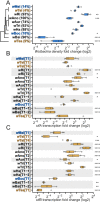cifB- transcript levels largely explain cytoplasmic incompatibility variation across divergent Wolbachia
- PMID: 35967981
- PMCID: PMC9364212
- DOI: 10.1093/pnasnexus/pgac099
cifB- transcript levels largely explain cytoplasmic incompatibility variation across divergent Wolbachia
Abstract
Divergent hosts often associate with intracellular microbes that influence their fitness. Maternally transmitted Wolbachia bacteria are the most common of these endosymbionts, due largely to cytoplasmic incompatibility (CI) that kills uninfected embryos fertilized by Wolbachia-infected males. Closely related infections in females rescue CI, providing a relative fitness advantage that drives Wolbachia to high frequencies. One prophage-associated gene (cifA) governs rescue, and two contribute to CI (cifA and cifB), but CI strength ranges from very strong to very weak for unknown reasons. Here, we investigate CI-strength variation and its mechanistic underpinnings in a phylogenetic context across 20 million years (MY) of Wolbachia evolution in Drosophila hosts diverged up to 50 MY. These Wolbachia encode diverse Cif proteins (100% to 7.4% pairwise similarity), and AlphaFold structural analyses suggest that CifB sequence similarities do not predict structural similarities. We demonstrate that cifB-transcript levels in testes explain CI strength across all but two focal systems. Despite phylogenetic discordance among cifs and the bulk of the Wolbachia genome, closely related Wolbachia tend to cause similar CI strengths and transcribe cifB at similar levels. This indicates that other non-cif regions of the Wolbachia genome modulate cif-transcript levels. CI strength also increases with the length of the host's larval life stage, presumably due to prolonged cif action. Our findings reveal that cifB-transcript levels largely explain CI strength, while highlighting other covariates. Elucidating CI's mechanism contributes to our understanding of Wolbachia spread in natural systems and to improving the efficacy of CI-based biocontrol of arboviruses and agricultural pests globally.
Keywords: Drosophila; Endosymbiosis; Wolbachia; host–microbe interactions; reproductive parasitism.
© The Author(s) 2022. Published by Oxford University Press on behalf of the National Academy of Sciences.
Figures



Similar articles
-
The impacts of cytoplasmic incompatibility factor (cifA and cifB) genetic variation on phenotypes.Genetics. 2021 Mar 3;217(1):1-13. doi: 10.1093/genetics/iyaa007. Genetics. 2021. PMID: 33683351 Free PMC article.
-
Male Age and Wolbachia Dynamics: Investigating How Fast and Why Bacterial Densities and Cytoplasmic Incompatibility Strengths Vary.mBio. 2021 Dec 21;12(6):e0299821. doi: 10.1128/mBio.02998-21. Epub 2021 Dec 14. mBio. 2021. PMID: 34903056 Free PMC article.
-
The CinB Nuclease from wNo Wolbachia Is Sufficient for Induction of Cytoplasmic Incompatibility in Drosophila.mBio. 2022 Feb 22;13(1):e0317721. doi: 10.1128/mbio.03177-21. Epub 2022 Jan 25. mBio. 2022. PMID: 35073749 Free PMC article.
-
Symbiont-mediated cytoplasmic incompatibility: what have we learned in 50 years?Elife. 2020 Sep 25;9:e61989. doi: 10.7554/eLife.61989. Elife. 2020. PMID: 32975515 Free PMC article. Review.
-
The Biochemistry of Cytoplasmic Incompatibility Caused by Endosymbiotic Bacteria.Genes (Basel). 2020 Jul 25;11(8):852. doi: 10.3390/genes11080852. Genes (Basel). 2020. PMID: 32722516 Free PMC article. Review.
Cited by
-
Transinfected Wolbachia strains induce a complex of cytoplasmic incompatibility phenotypes: Roles of CI factor genes.Environ Microbiol Rep. 2023 Oct;15(5):370-382. doi: 10.1111/1758-2229.13169. Epub 2023 May 16. Environ Microbiol Rep. 2023. PMID: 37194361 Free PMC article.
-
Describing endosymbiont-host interactions within the parasitism-mutualism continuum.Ecol Evol. 2024 Jul 4;14(7):e11705. doi: 10.1002/ece3.11705. eCollection 2024 Jul. Ecol Evol. 2024. PMID: 38975267 Free PMC article.
-
Counting rare Wolbachia endosymbionts using digital droplet PCR.bioRxiv [Preprint]. 2024 Dec 11:2024.12.10.627731. doi: 10.1101/2024.12.10.627731. bioRxiv. 2024. Update in: Microbiol Spectr. 2025 Jun 3;13(6):e0326624. doi: 10.1128/spectrum.03266-24. PMID: 39713442 Free PMC article. Updated. Preprint.
-
Rapid host switching of Wolbachia and even more rapid turnover of their phages and incompatibility-causing loci.bioRxiv [Preprint]. 2024 Jun 23:2023.12.04.569981. doi: 10.1101/2023.12.04.569981. bioRxiv. 2024. PMID: 38105949 Free PMC article. Preprint.
-
Counting cytoplasmic incompatibility factor mRNA using digital droplet PCR.bioRxiv [Preprint]. 2025 Jul 30:2025.07.30.667682. doi: 10.1101/2025.07.30.667682. bioRxiv. 2025. PMID: 40766715 Free PMC article. Preprint.
References
-
- McCutcheon JP, Boyd BM, Dale C. 2019. The life of an insect endosymbiont from the cradle to the grave. Curr Biol. 29:R485–R495. - PubMed
-
- Archibald JM. 2015. Endosymbiosis and eukaryotic cell evolution. Curr Biol. 25:R911–R921. - PubMed
-
- Dedeine F, Bouletreau M, Vavre F. 2005. Wolbachia requirement for oogenesis: occurrence within the genus Asobara (Hymenoptera, Braconidae) and evidence for intraspecific variation in A. tabida. Heredity. 95:394–400. - PubMed
-
- Taylor MJ, Bandi C, Hoerauf A. 2005. Wolbachia bacterial endosymbionts of filarial nematodes. Adv Parasitol. 60:245–284. - PubMed
Grants and funding
LinkOut - more resources
Full Text Sources

